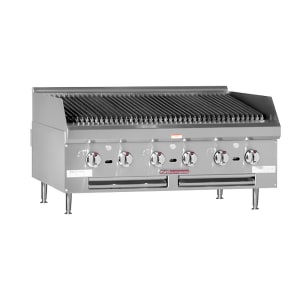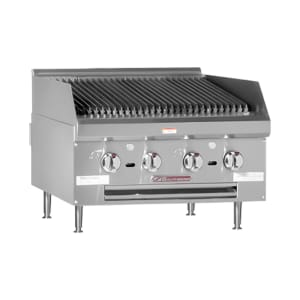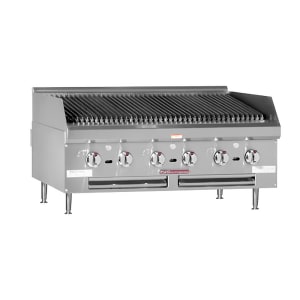Restaurant & Commercial Charbroilers
When buying a charbroiler, you will have to decide on fuel source, grate material and type, and whether you want metal radiants, lava rocks, or ceramic bricks. More

Gas charbroilers will operate on either propane (LP) or natural gas, but many models are convertible for additional flexibility.

These charbroilers use electric power to generate heat. Check the unit's voltage to be sure it is compatible with your kitchen.
What to Know About Commercial Charbroilers
Charbroilers are powerful and varied pieces of commercial cooking equipment, and the right commercial charbroiler can add a huge array of tasty dishes to your menu. Commercial charbroilers, also called commercial grills, come in several capacities, fuel sources, and radiant types, each of which can change how you use the piece in your establishment. If you're serving grilled foods as one of your main menu items – for example, burgers in a diner – you'll need a full-size floor model to keep up with demand. On the other hand, if you're only grilling a handful of items, a smaller countertop model can help you meet that demand without requiring as much space or initial investment.
Charbroilers use gas or electricity to heat up metal radiants above the burner. The radiants then heat up food placed on top of them. Some charbroilers utilize lava rocks or char rocks instead of metal radiants. The rocks and flame combine to cook the food in these models, with the rocks catching and vaporizing the drippings. Commercial grill grates have gaps in the cooking surface that enable grease and juices to drop down from the cooking food and onto the burner, evaporating the liquid and sending the smoke back into the food. This method of cooking leaves distinct, attractive grill marks on food and infuses the flavors of the drippings back into it.
Gas is by far the most common utility used in commercial charbroilers, with either natural gas or LP (also commonly called propane) preferred depending on which is easier to use. However, there are electric models as well that use heating elements instead of a flame burner. Electric units are beneficial because they can be moved easily from place to place, as there is no gas connection to worry about. Electric charbroilers are great for catering, food trucks, or any establishment that only occasionally needs its unit, so it can be stored away when not in use.
Common Questions About Charbroilers
What are the commercial charbroiler grate types?
Welded grates are the most common and economical. Their rods are permanently welded to a frame, creating a rigid, durable grate. The downside is their welds tend to become weak over time from the material heating and cooling, and the grate will need to be replaced if the welds begin to break. Floating grates are made with free-floating rods that aren't fully welded to their frame, enabling them to expand and contract freely as they are heated and cooled. They tend to stay strong and not wear out as quickly as welded grates.
Another option is reversible grates, which have ridges on one side that are thicker than the other side, so you can flip them over to cook different types of food. Steak, for example, is best cooked on thicker ridges because they help drain grease and provide good heat distribution for thicker products. More delicate items, such as fish, are best cooked on thinner ridges that offer more support and have less surface area, which reduces the likelihood your foods will stick. Sectional grates are composed of individual sections, so they can be adjusted and reversed for simultaneously cooking multiple types of items.
What is a commercial grill grate profile?
Grate profile refers to the way the grate sits on the unit: flat or slanted. Flat grates are what you want if you're mostly going to cook a single type of item – if you specialize in burgers, for instance. Heat distribution is mostly uniform across a flat grate, and juices drip straight down onto the radiants or char rocks to become vaporized, creating the classic chargrilled aroma and flavor.
Slanted grates sit above the heat source at an angle, so the raised part is further away from the heat of the unit's burner. This arrangement will enable you to cook food on the higher portion at lower temperatures and is useful for cooking steaks to different doneness levels on the same unit, with well-done steaks on the lower part and rare steaks on the higher portion. Food on the higher portion can also be held and kept warm until serving time. Slanted grates can help minimize the chance of flare ups and grease fires because more grease will drip down the grates into the grease tray rather than onto the radiants or rocks.
For the best of both worlds, consider choosing a unit with adjustable grates. These can be arranged to sit flat or at an angle, so you can cook foods that do best on either. Often, a unit's grate will come in several individual pieces, so you can have flat and slanted surfaces at the same time.
What fuel sources are available for charbroilers?
Most of these units come in either natural gas or propane (LP). Natural gas usually comes through a network built by a utility line, but propane is stored outside your building in a holding tank and refilled periodically by a gas company. Your decision will probably be determined by which resource you have access to or which is more affordable.
Are electric commercial charbroilers available?
Although their numbers are few, electric charbroilers are available, with mobility being their main advantage. Since gas models need to be connected to a gas line, they are difficult to relocate if you need to move them, and in most cases, you can simply unplug an electric unit and store it away or move it. This makes an electric model a great choice if you only want to use it occasionally or if you are going to use it for catering.
How do commercial grills transfer heat?
Heat in a commercial charbroiler is produced by a series of burners. Above the burners, heat is absorbed and spread out evenly with the help of metal radiants or pieces of stone. Metal radiants are made of either steel or cast iron. Cast iron radiants can be slow to heat, but once they are hot, they retain their heat very well and cook efficiently. Steel radiants are easier to keep clean but don't retain heat quite as well.
Some electric models transfer heat through a sheathed element. In these, the element is encased in a tube that acts as a radiant, absorbing heat from the element inside and radiating it evenly towards the cooking surface.
The alternatives to metal radiants are ceramic briquettes and lava rocks. Lava rocks will absorb and vaporize juices to achieve a classic smoky flavor but tend to cause flare ups that some operators might want to avoid. Ceramic briquettes are designed to radiate the heat and vaporize juices without the flare ups. These are both consumable items, so they must be replaced periodically, depending on how frequently you use your equipment and what kinds of foods you cook.








